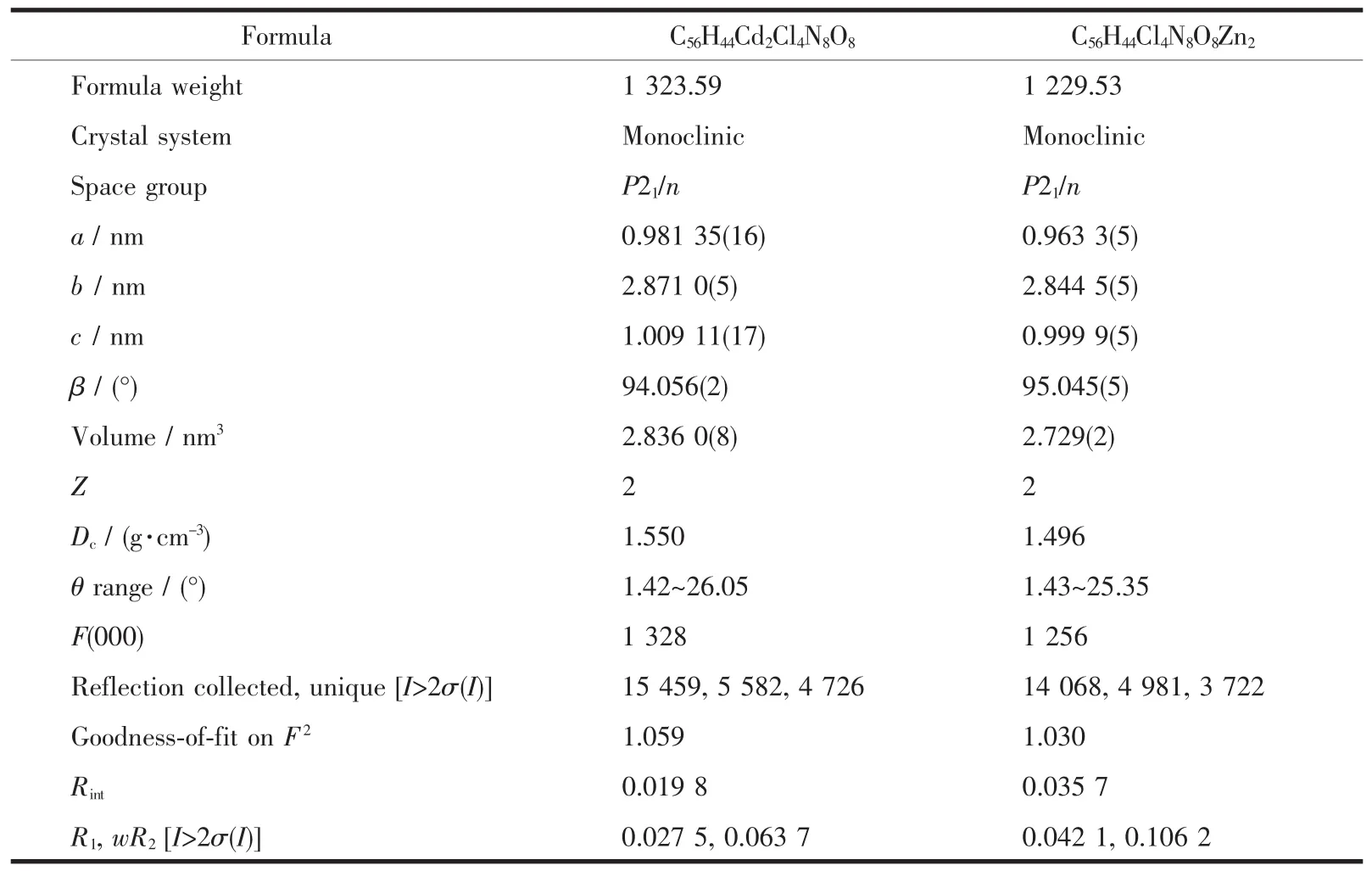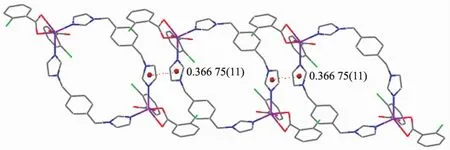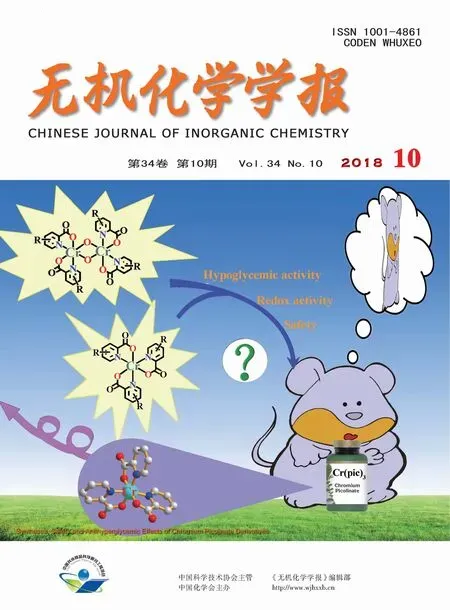两个镉/锌超分子配合物的合成、晶体结构及理论计算
2018-10-12李秀梅潘亚茹常鹰飞
李秀梅 潘亚茹 刘 博 周 实 常鹰飞
(1通化师范学院化学学院,通化 134002)
(2吉林师范大学环境友好材料制备与应用省部共建教育部重点实验室,四平 136000)
(3东北师范大学化学学院,长春 130024)
Coordination polymers with bridged transition metals have received intense interest and attention for their fascinating architectures and potential applications as materials in optical,electronic,magnetic fields,gas storage,catalysis and so on[1-5].Consequently,numerous new complexes can be specially designed by the careful selection ofmetal centerswith preferred coordination geometries[6-9]. It has been observed that organic ligands play crucial roles in the preparation of some interesting coordination networks,such as flexibility,donating type,and the geometry of organic ligands[10-11].Among various organic ligands,aromatic carboxylates have been extensively used because of their extension ability in both covalent bonding and supramolecular interactions(H-bonding and aromatic stacking).For example,benzoic acid,1,3-benzenedicarboxylate,1,4-benzenedicarboxylate,1,2-benzenedicarboxylate,and 1,2,4,5-benzene tetracarboxylate[12-14]are well used in the construction of CPs due to their structural rigidity,chemical stability and appropriate connectivity.Besides the carboxylate linkers,bis(imidazole)bridging ligands with different length and flexibly,for example,1,3-bis(imidazol-1-ylmethyl)-benzene,1,4-bis(imidazol-1-ylmethyl)-benzene,1,4-bis(imidazol-1-yl)-butane are frequently used in the assembly process of CPs as bridging linker[13-15].
Based on all the aspects stated above,herein we report the synthesis and crystal structure of two coordination supramolecules,[Cd(cba)2(bix)]2(1)and[Zn(cba)2(bix)]2(2).In the solid state,complexes 1 and 2 form a three-dimensional(3D)network resulted from π-π stacking interactions.
1 Experimental
1.1 General procedures
All reagents were purchased commercially and used without further purification.Elemental analyses(C,H and N)were measured on a Vario ELⅢElemental Analyzer.IR spectrum was recorded in the range of 4 000~400 cm-1on a Nicolet 6700 spectrometer using a KBr pellet.TG studies were carried on a STA7300 analyzer under nitrogen at a heating rate of 10℃·min-1.The fluorescent spectra were obtained on a computer-controlled JY Fluoro-Max-3 spectrometer at room temperature. The power X-ray diffraction (PXRD)studies were performed with a Bruker D8 Discover instrument(Cu Kα radiation,λ=0.154 184 nm,U=40 kV,I=40 mA)over the 2θrange of 5°~50°at room temperature.
1.2 Synthesis
The pH valueof themixtureof0.2mmolM(OAc)2·2H2O(M=Cd,1;Zn,2),Hcba(0.3mmol,0.047 g),bix(0.3 mmol,0.071 5 g),1 mL C2H5OH and 9 mL H2O was adjusted to 7 with 40%NaOH,sealed in a Teflon-lined stainless steel vessel,heated to 120℃for 5 days,and followed by slow cooling(a descent rate of 5℃·h-1)to room temperature.Colorless block crystals were obtained.
[Cd(cba)2(bix)]2(1):Yield:25%(based on Cd).Anal.Calcd.for C56H44Cd2Cl4N8O8(%):C,50.81;H,3.35;N,8.47.Found(%):C,50.05;H,2.96;N,8.02.IR (cm-1):3 118w,1 581s,1 555s,1 517s,1 432w,1 388s,1 279w,1 234w,1 107m,1 086m,1 051w,934w,850w,749m,723w,695s,652s,620w.
[Zn(cba)2(bix)]2(2):Yield:32%(based on Zn).Anal.Calcd.forC56H44Cl4N8O8Zn2(%):C,54.70;H,3.61;N,9.11.Found(%):C,54.05;H,3.14;N,8.62.IR(cm-1):3 431w,3 134w,1 623s,1 521w,1 432w,1 358s,1 101 m,1 051w,955w,849w,750m,651w.
1.3 Structure determ ination
Single-crystal X-ray diffraction data for 1 and 2 were recorded on a Bruker D8 QUEST CMOS diffractometer with graphite-monochromated Mo Kα radiation(λ=0.071 073 nm)at 293 K.The structures were solved with the direct method of SHELXS-97 and refined with full-matrix least-squares techniques using the SHELXL-97 program[16-17].The non-hydrogen atoms of the complexes were refined with anisotropic temperature parameters.The hydrogen atoms attached to carbons were generated geometrically.In addition,there is disorder in complexes 1 and 2.Crystallographic parameters and the data collection statistics for structures 1 and 2 are given in Table 1.Selected bond lengths and bond angles are listed in Table 2.
CCDC:1829184,1;1828811,2.
2 Results and discussion
2.1 Description of the structure
The single-crystal X-ray diffraction study reveals that complexes 1 and 2 are isomorphic.They all crystallize in monoclinic space group P21/n and feature zero-dimensional structure.Here,only thestructure of complex 1 is described.The structure of complex 1 is shown in Fig.1,the coordination of Cd ion can be described as a distorted tetragonal-pyramidal geometry.Each Cdギion in 1 is coordinated by three carboxylate oxygen atoms from two different cba ligands,and two nitrogen atom donors from two bridging bix ligands.The Cd-O bond distances are in the range of 0.232 84(19)~0.264 4(2)nm,and those of Cd-N are from 0.225 80(18)to 0.226 57(19)nm.The N(O)-Cd-O(N)angles fall in the 51.51(7)°~137.88(8)°range.

Table 1 Crystal data and structure refinement for 1 and 2

Table 2 Selected bond lengths(nm)and bond angles(°)for 1 and 2
In complex 1,the bix ligands take cisconformation bridging mode with a dihedral angle between the two imidazole rings of 59.09°,and the cba ligand coordinates to Cd ions through three carboxylic oxygen atoms in a monodentate and bidentate fashion,which gives rise to a double-nuclear subunit(Fig.1).It should be mentioned that in the unit of 1 one type of 26-membered ring is formed(N(1)-Cd(1)-N(4)111.52°,Cd…Cd 1.246 3 nm).

Fig.1 Molecular structure of complex 1
Further investigation of the crystal packing of complex 1 suggests that there are persistent π-π interactions in complex 1 between imidazole rings of bix ligands.The centroid-to-centroid distance between adjacent ring is 0.377 37(17)nm for N3C26N4C28C27 and N3′C26′N4′C28′C27′(Symmetry codes:-1-x,-y,-z)imidazole rings.The perpendicular distance is 0.366 75(11)nm for N3C26N4C28C27 and N3′C26′N4′C28′C27′(Symmetry codes:-1-x,-y,-z)imidazole rings.Therefore,through π-π interactions,complex 1 is further extended into a three-dimensional supramolecular framework(Fig.2).

Fig.2 View of the 3D supramolecular structure of complex 1 formed byπ-π interactions
To investigate whether the analyzed crystal structure is truly representative of the bulk materials,X-ray powder diffraction(PXRD)technology has been performed for complex 1 at room temperature(Fig.3).The main peak positions observed are in good agreement with the simulated ones.Although minor differences can be found in the positions,widths,and intensities of some peaks,the bulk synthesized materials and analyzed crystal can still be considered as homogeneous.The differences may be due to the preferred orientation of the powder samples[18-19].

Fig.3 PXRD analysis of complex 1
2.2 Thermal analysis
To characterize the thermal stability of complexes 1 and 2,TG curves have been obtained from crystalline samples in the flowing nitrogen atmosphere at a heating rate of 10℃·min-1.As depicted in Fig.4,the TG curve of 1 shows that the complex is stable up to 240℃,and then decompose upon further heating.The TG curve of 2 shows that the complex is stable up to 230℃,and then decompose upon furtherheating.

Fig.4 TG curves of complexes 1 and 2
2.3 Photolum inescent property
Luminescence property is very significant in photochemistry and photophysics[20-21].The solid-state photoluminescence spectra of 1 and 2 were measured at room temperature (Fig.5).Excited by 325 nm,complex 1 exhibits blue emission with the maximum peak at 418 nm.Complex 2 gives blue photoluminescence with an emission maximum at 426 nm upon excitation at 301 nm.In order to study the nature of these emission bands,we first analyzed the photoluminescence properties of free bix,Hcba ligands,and confirmed that they do not emit any luminescence in the range of 400~800 nm.Therefore,on the basis of the previous literature[22],the emission band could be vested to the emission of ligand-to-metal charge transfer(LMCT).

Fig.5 Solid-state emission spectrum of 1 and 2 at room temperature
3 Theoretical calculation
All calculations in this work were carried out with the Gaussian09 program[23].The parameters of the molecular structure for calculation were all from the experimental data of the complex.Natural bond orbital(NBO)analysis was performed by density functional theory(DFT)[24]with the PBE0[25-28]hybrid functional and the LANL2DZ basis set[29].
The selected natural atomic charges,natural electron configuration,wiberg bond and NBO bond orders(a.u.)for the complex 1 are shown in Table 3.It is indicated that the electronic configurations of Cd(1)ion,N and O atoms are 5s0.324d9.985p0.30,2s1.382p4.22~4.23and 2s1.68~1.712p5.02~5.06,respectively.Based on the above results,one can conclude that the Cd(1)ion coordination with N and O atoms ismainly on 4d,5s and 5p orbitals.N atoms form coordination bonds with Cd(1)ion using 2s and 2p orbitals.All O atoms supply electrons of 2s and 2p to Cd(1)ion and form the coordination bonds.Therefore,the Cd(1)ion obtained some electrons from two N atoms of bix ligands and three O atoms of cba ligands[30].Thus,according to valence-bond theory, the atomic net charge distribution and the NBO bond orders of the complex 1 (Table 3)shows the obvious covalent interaction between the coordinated atoms and Cd(1)ion.The differences of the NBO bond orders for Cd-O and Cd-N bondsmake their bond lengths different[31],which is in good agreement with the X-ray crystal structure of complex 1.
As can be seen from the Fig.6,lowest unoccupied molecular orbital(LUMO)is mainly composed ofπorbits of imidazole rings in bix ligand,whereas highest occupied molecular orbital(HOMO)mainly consists of πorbits of benzene rings in bix ligand.So,ILCTmay be inferred from some contours ofmolecular orbital of complex 1.

Table 3 Natural atom ic charges,natural valence electron configurations,w iberg bond indexes and NBO bond orders for 1

Fig.6 Frontiermolecular orbitals of complex 1
